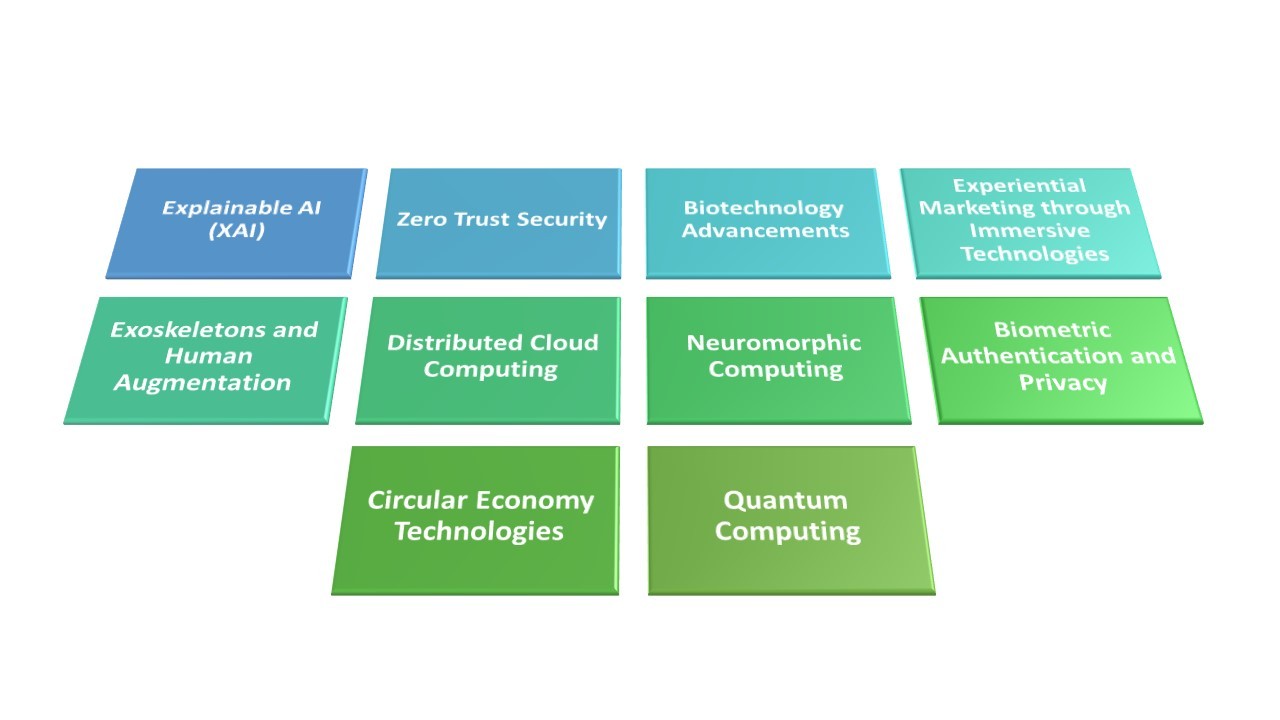Comments
- No comments found

In the ever-evolving landscape of technology, staying ahead of the curve is vital for businesses, governments, and individuals alike.
To help you navigate this dynamic realm, we've compiled a comprehensive exploration of ten strategic technology trends that are shaping the future. These trends encompass the fields of artificial intelligence (AI), cybersecurity, biotechnology, immersive experiences, and more.

Explanation: Explainable AI (XAI) is a critical aspect of artificial intelligence (AI) that seeks to enhance the transparency and interpretability of AI systems. In a world where AI influences numerous aspects of our lives, from healthcare to finance, it's imperative that we understand how AI systems make decisions. XAI techniques enable users to comprehend and trust AI-driven predictions by offering transparent explanations for model outputs.
Example: Imagine a healthcare AI that assists doctors in diagnosing diseases based on medical imaging. XAI ensures that the AI doesn't just provide a diagnosis but also explains the specific features it considered to reach that conclusion, giving medical professionals the confidence to make informed decisions.
Explanation: Zero Trust Security is a paradigm shift in cybersecurity. Traditionally, network security operated under the "trust but verify" model, but in an age of increasing cyber threats, this approach is no longer sufficient. Zero Trust Security assumes that no entity, whether inside or outside a network, should be inherently trusted. It emphasizes continuous verification of users and devices, regardless of their location or network connection, effectively creating a security perimeter around every device and user.
Example: A company implements a Zero Trust Security framework to protect its sensitive data. Every employee, whether working from the office or remotely, is continuously verified before accessing company resources, reducing the risk of data breaches.
Explanation: Biotechnology encompasses a vast array of innovations in the fields of biology and genetics. One of the most transformative advancements is CRISPR-Cas9, a gene-editing technology that allows precise modification of DNA. This technology has implications for medicine, agriculture, and environmental conservation.
Example: In medicine, CRISPR-Cas9 is used to treat genetic diseases by editing the patient's DNA. In agriculture, it enhances crop yields and disease resistance through genetic modification, and in environmental conservation, it can potentially be used to modify organisms for pollution cleanup.
Explanation: Experiential marketing is undergoing a revolution with the integration of immersive technologies such as augmented reality (AR) and virtual reality (VR). These technologies enable brands to engage customers on a much deeper level, offering interactive and memorable experiences.
Example: Retailers are using AR apps that allow customers to virtually try on clothing or visualize how furniture and decor items would fit in their homes. This immersive experience enhances customer engagement and aids in purchasing decisions.
Explanation: Exoskeletons and human augmentation technologies are wearable devices that enhance human capabilities. They find applications in industries like manufacturing, where they can reduce physical strain, and in healthcare, aiding in rehabilitation and mobility for individuals with disabilities.
Example: In manufacturing, exoskeletons can be worn by workers to assist in heavy lifting and repetitive tasks, reducing the risk of injury and increasing productivity. In healthcare, they help individuals with mobility impairments regain the ability to walk.
Explanation: Distributed cloud computing represents an evolution in cloud technology. It allows cloud resources to be spread across multiple locations while still being centrally managed. This approach minimizes data latency and enhances accessibility by placing data and processing closer to end-users or devices, making it ideal for applications requiring low-latency access.
Example: In the realm of online gaming, distributed cloud computing enables players to experience low-latency gameplay, regardless of their geographical location. Data and processing are optimized for a seamless gaming experience.
Explanation: Neuromorphic computing is an emerging field inspired by the structure and function of the human brain. It aims to create more efficient and brain-like processing. Neuromorphic chips process information in a manner similar to neurons, potentially improving the efficiency and adaptability of AI systems.
Example: Neuromorphic computing has the potential to revolutionize robotics by enabling robots to process sensory information in a manner more akin to human cognition. This can lead to robots that are more intuitive and adaptable in various tasks.
Explanation: Biometric authentication uses unique biological or behavioral traits, such as fingerprints or facial features, to verify a user's identity. While highly secure, it is essential to ensure the privacy and security of biometric data.
Example: Mobile devices utilize biometric authentication, such as facial recognition or fingerprint scanning, for unlocking and authorizing payments. These systems store biometric data securely, encrypt it, and adhere to strict privacy regulations to protect user privacy.
Explanation: Circular economy technologies promote sustainability by reusing and recycling materials. They encompass innovative recycling processes, sustainable materials, and 3D printing with recycled plastics, ultimately reducing waste and contributing to a more eco-friendly approach to manufacturing and consumption.
Example: A company adopts 3D printing technology that utilizes recycled plastics. This not only reduces waste but also minimizes the environmental impact associated with plastic production.
Explanation: Quantum computing is a revolutionary technology that harnesses the principles of quantum mechanics to perform complex computations at unprecedented speeds compared to classical computers. Quantum bits (qubits) can exist in multiple states simultaneously, enabling quantum computers to tackle problems previously deemed unsolvable.
Example: Quantum computing has the potential to disrupt various industries, such as cryptography. Large-scale quantum computers could break existing encryption methods, making data more vulnerable unless new, quantum-resistant cryptographic techniques are developed.
Incorporating these strategic technology trends into your business strategy or understanding their implications for your industry is essential for staying competitive and relevant in today's rapidly changing technological landscape. Each of these trends represents a significant step forward in the world of technology, and their impact will continue to shape the way we live and work in the years to come.
Ahmed Banafa is an expert in new tech with appearances on ABC, NBC , CBS, FOX TV and radio stations. He served as a professor, academic advisor and coordinator at well-known American universities and colleges. His researches are featured on Forbes, MIT Technology Review, ComputerWorld and Techonomy. He published over 100 articles about the internet of things, blockchain, artificial intelligence, cloud computing and big data. His research papers are used in many patents, numerous thesis and conferences. He is also a guest speaker at international technology conferences. He is the recipient of several awards, including Distinguished Tenured Staff Award, Instructor of the year and Certificate of Honor from the City and County of San Francisco. Ahmed studied cyber security at Harvard University. He is the author of the book: Secure and Smart Internet of Things Using Blockchain and AI.
Leave your comments
Post comment as a guest